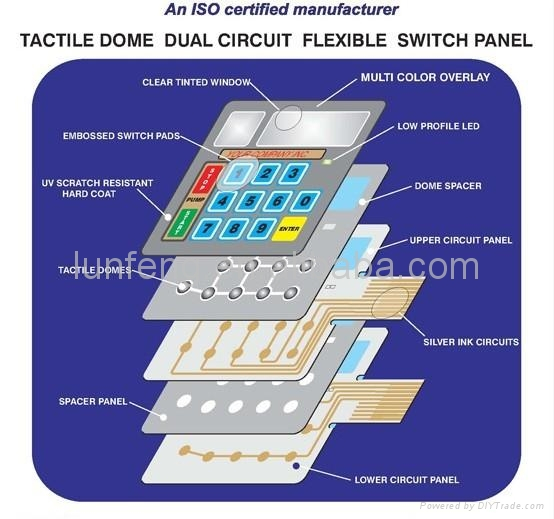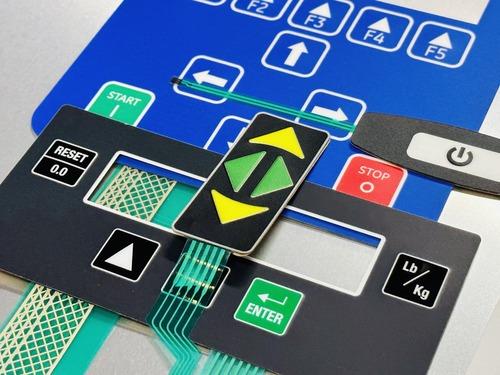Understanding the Technology Behind Membrane Switches
Understanding the Technology Behind Membrane Switches
Blog Article
Discover Just How Membrane Switches Feature and Their Role in Modern Electronics
Membrane Switches stand for an innovative combination of innovation and design within the world of modern-day electronics, acting as necessary interfaces in numerous tools. Included numerous layers, these switches make use of pressure-sensitive mechanisms to facilitate individual communication. Their applications extend different sectors, from consumer electronic devices to medical tools, highlighting their versatility and value. Comprehending the details of Membrane button functionality and their wider implications in boosting individual experience invites more exploration into their style, benefits, and the ingenious developments forming their future in modern technology.
What Are Membrane Switches?

Membrane switches are identified by their toughness and resistance to environmental factors, such as dust, wetness, and extreme temperature levels. They can be tailored with various graphics, colors, and tactile feedback alternatives, enhancing customer experience while keeping aesthetic charm - membrane switches. The incorporation of published circuits permits for seamless assimilation right into devices, enhancing overall functionality.
The flexibility of Membrane switches is noticeable in their capacity to support both complex and simple control functions. They can integrate functions such as LED indicators and touch-sensitive modern technology, accommodating certain customer requirements. As innovation remains to progress, Membrane Switches stay important for enabling intuitive and reliable interface, consequently playing an essential function in the improvement of modern electronic gadgets.
Elements of Membrane Switches
Membrane buttons are made up of a number of essential elements that function with each other to produce a trustworthy and practical user interface. The main elements consist of the graphic overlay, sticky layer, spacer layer, and conductive traces.
The visuals overlay functions as the interface, typically published on a versatile substrate such as polyester or polycarbonate. This layer not just offers aesthetic allure yet additionally consists of responsive comments, aesthetic cues, and safety functions. Below the graphic overlay lies the sticky layer, which protects the button to the device and ensures sturdiness versus ecological stress and anxieties.
The spacer layer is important for keeping the necessary gap between the visuals overlay and the circuit layer. When stress is applied, this space allows for the activation of the switch. The conductive traces, typically made from silver or carbon, create the electric pathways that finish the circuit when the switch is engaged.
In addition, a support layer may be included for structural support and insulation. These parts team up perfectly, making internet certain that Membrane buttons are both resilient and straightforward, making them essential in various modern electronic applications.
Exactly How Membrane Switches Job
Just how do Membrane Switches feature successfully within electronic tools? Membrane Switches run on the principles of pressure-sensitive technology, making use of a layered construction that consists of graphic overlays, glue layers, and conductive aspects.
The design of Membrane switches is critical for their efficient operation (membrane switches). The layers are diligently engineered to provide responsive feedback, longevity, and resistance to environmental factors such as dampness and dust. The incorporation of domes-- small, elevated areas within the button-- enhances tactile response, supplying users with an obvious click sensation upon activation
Additionally, Membrane switches can be tailored in terms of size, form, and graphics, making them suitable for different applications. They are often utilized in control panels, clinical tools, and customer electronic devices because of their streamlined style and reliability. Generally, the efficient functioning of Membrane buttons is critical in boosting customer interaction and making sure smooth operation in contemporary digital tools.

Applications in Modern Instruments
Utilizing their distinct style and performance, Membrane buttons have actually come to be integral components in a large range of modern-day digital tools. These functional user interfaces are used in consumer electronics, industrial equipment, medical devices, and automotive controls, offering seamless user interaction.
In consumer electronics, Membrane buttons are commonly found in appliances like microwaves, cleaning equipments, and various other house tools, where they make it possible for intuitive control with a streamlined account. Their inconspicuous style assists in combination into compact devices, boosting visual charm without jeopardizing functionality.
In industrial applications, Membrane Switches act as control panels for equipment, using toughness and resistance to extreme atmospheres. Their ability to withstand dampness and impurities makes them excellent for usage in production and processing industries.
Clinical gadgets likewise benefit from Membrane switches, which are developed to be very easy to tidy and preserve, ensuring health in scientific settings. They are often made use of in diagnostic equipment, individual tracking systems, and mobile medical devices, where dependability is critical.
Benefits of Membrane Buttons
One of the key advantages of Membrane switches is their versatility, which enables them to be tailored for a range of applications throughout several sectors. These switches can be made in different forms and sizes, suiting distinct item requirements while giving seamless combination into gadgets. Their slim profile allows a sleek and small style, often improving the visual appeal of electronic items.
Another considerable benefit is their resilience - membrane switches. Membrane buttons are generally immune to dirt, useful source moisture, and chemicals, making them optimal for rough environments. This durability expands their life-span compared to standard mechanical switches, lowering the need for regular replacements
Furthermore, Membrane Switches offer cost-effectiveness. The manufacturing process involves printing innovations that reduce production expenses, particularly for big runs. This price, combined with low upkeep demands, makes them an appealing choice for manufacturers.

Conclusion
In conclusion, Membrane Switches stand for a substantial innovation in customer interface technology within modern electronics. As the need for resistant and instinctive interfaces proceeds to grow, the duty of Membrane buttons in shaping user experience will unquestionably expand.
Membrane Switches represent a sophisticated assimilation of technology and layout within the world of modern-day electronics, serving as essential interfaces in various devices.In the realm of modern electronic devices, Membrane Switches serve as look at more info vital components that assist in individual interaction with gadgets. As innovation proceeds to progress, Membrane Switches continue to be essential for allowing effective and user-friendly individual interfaces, consequently playing a crucial duty in the development of modern-day digital tools.
How do Membrane Switches feature properly within electronic tools? On the whole, the reliable performance of Membrane switches is pivotal in boosting user interaction and ensuring smooth procedure in modern-day digital gadgets.
Report this page